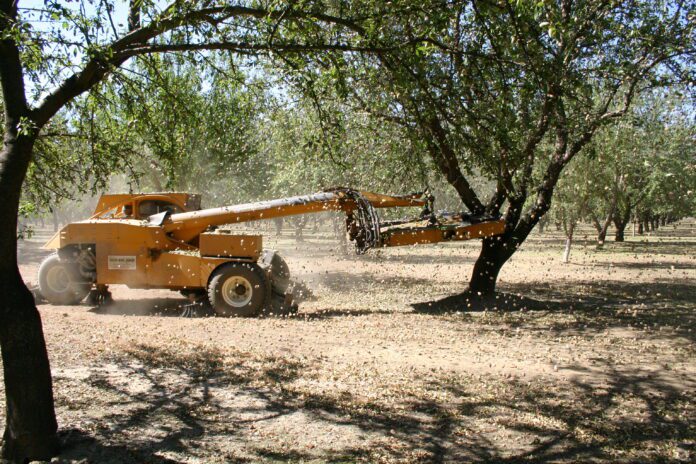
Important components of an efficient and successful almond harvest include irrigation management, harvest timing, orchard floor preparation and dust mitigation practices.
Leading up to harvest, growers and crop managers develop strategies for orchard irrigation timing and rates, following ET, using a pressure bomb and/or moisture sensors. They also allow for varietal differences in maturity where they have irrigation flexibility. Smooth, clean, hard floors are the goal for picking up cleaner loads and minimizing dust. Hull split sprays timed for navel orangeworm (NOW) control and scouting for protein-feeding ants are included in the plans. The goal is to avoid tree stress, achieve maximum removal of nuts and avoid tree injury and insect damage.
In a Growing the Valley podcast, UCCE Farm Advisors Franz Niederholzer and Luke Milliron agreed water management is a critical part of the harvest plan. Strategic water management can affect crop quality and tree health and can yield economic benefits.
“June and July are critical times for kernel dry weight growth when fats and proteins accumulate inside the shell,” Niederholzer said. This weight increase is driven by healthy leaf function (photosynthesis) supported by good water management. Water management leading up to harvest can also help reduce stick/hull tight. Trees can tolerate some moderate water stress early in hull split, but that time is passed, and kernel weight increase is best supported by low water stress (good irrigation practices) between 90% hull split and preharvest irrigation cut-off.
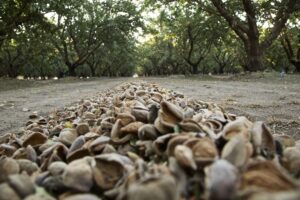
Outline for Harvest Preparation
July is the last full month before harvest. What is done in July can have a major impact on crops this year and next year. Especially this year, with high risk of NOW damage, practices in July and into August will impact growers’ bottom lines.
Water management
Drought in July means:
• Lower kernel weights
• Possible stress on buds differentiating for next year
• High stress = stick tights/hull tights
• Possible leaf loss
Drought during harvest means:
• Possible reduced yield in future years due to leaf loss following extended irrigation shut-off during harvest.
Orchard floor prep
Clean and flat = easier pickup, no lost nuts
Ant management
Ant bait should go out up to eight weeks before harvest (shake) depending on the product. Talk with your PCA regarding materials and timings.
Harvest timing
Timely harvest is after 100% hull split. This is earlier than traditional timing for in-shell product, but if this harvest is ahead of egg laying for the third flight of NOW, damage will be reduced. Drying time on the orchard floor is longer with timely harvest, leaving the crop exposed to ant damage if ants aren’t controlled.
Dust management
For on-farm and off-farm safety, manage harvest dust.
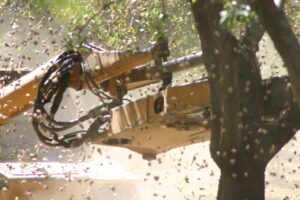
Water During Harvest
He explained water stress during harvest, especially when there is a long interval between irrigation shutoff and the next irrigation, can also impact future yield. Many growers are now limiting the time irrigation is off during harvest. Niederholzer said he has observed growers with double-line drip systems avoid water stress in all varieties by blowing Nonpareil nuts away from drip lines within 48 hours of shaking and irrigating carefully to avoid getting water on the drying nuts. Some Independence variety growers blow nuts into every other row middle and irrigate with one of two drip lines on each row where the nuts have been cleared out. The goal in all examples is to limit, as much as possible, water stress in the orchard while allowing the nuts to dry.
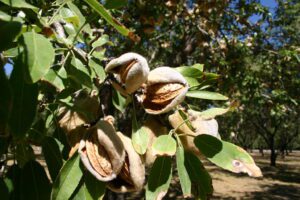
An almond orchard is ready for “timely harvest” any time after 100% hull split; the last nuts down low in the canopy are split (the hull pops open when the ends are squeezed together.) This is earlier than traditional timing for in-shell product, but if this harvest is ahead of egg laying for the third flight of NOW, damage will be reduced. In a year with heavy NOW pressure in many orchards, it may be advisable to deliver cleaner kernels than wormy inshell product. Drying time on the orchard floor is longer with timely harvest, leaving the crop exposed to ant damage if ants aren’t controlled.
Timely harvest can prevent serious NOW damage. Taking out the Nonpareils in a timely manner can lessen worm pressure for later varieties. Ant bait spread in orchards as early as eight weeks prior to anticipated harvest (shake) can reduce ant populations. Talk with your PCA about materials, rates and timings. Fresh ant bait should be applied to dry ground for the best possible results.
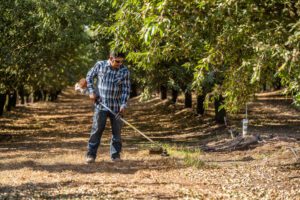
Successful Shakes
Successful shakes depend on formation of an abscission layer between the nut and peduncle. This stage is optimal for nut removal. Waiting increases the chances for stick tights. Shaking can be initiated when interior orchard trees reach 100% hull split.
Initiation of shaking before full maturity can also cause damage. Niederholzer noted that ‘barking’ of trees occurs when machinery is not calibrated and adjusted properly. Shaking harder or longer to dislodge nuts causes barking which can provide a trunk and scaffold pathogen entry to trees. Shaking harder to get nuts off, especially young trees, can cause permanent bark damage. Ideally, he said younger trees may be shaken later after mature trees as the cambium layer is stronger later in the season. He noted research by UC Davis Pomologist Ken Shackel found bark strength of trees is not related to stem water potential but that the bark cambium gets stronger and less vulnerable to barking the later in the year shaking is done.
Orchard floor preparation prior to harvest is done with a goal of a vegetation-free, clean, smooth floor. This helps with a cleaner harvest and mitigates dust.
Use of herbicides to burn down cover crops or native vegetation is common, but Niederholzer said material choice is important. Some growers are trying to avoid use of glyphosate due to export market concerns, he said. There are other burndown options. Check with your PCA regarding materials and rates.
Being aware of the need for dust management is critical for orchard and public safety, Niederholzer said. Dust reduction during sweeping and harvest is also one of Almond Board of California’s (ABC) 2025 goals for the industry.
Creating a clean orchard floor is the first step a grower can take to reduce dust at harvest. Removing vegetation, sticks, rocks and other debris and filling in any low spots or holes makes for cleaner loads arriving at the huller and fewer nuts rolling into holes and being left behind.
Planning routes for equipment so that dust is blown back into the orchard rather than out near roads or residences is part of dust reduction. Trees can capture and filter dust. Working from the outside in and going slower reduces dust. Niederholzer noted that proper adjustment of equipment is also part of best management practices for dust mitigation. Do not set sweeper heads lower than necessary to move the crop. Wire tines can be set as high as a half inch off the ground and still be effective. Sweeper head set lower will move more dirt into the windrow and result if excessive dust when nuts are picked up.
Finally, slowing down harvest equipment can help. Taking almond harvester ground speeds down a notch can reduce harvest-generated dust. ABC notes a pick-up speed of 1.5 mph cuts dust 50% compared to 3 mph.

Cecilia Parsons | Associate Editor
Cecilia Parsons has lived in the Central Valley community of Ducor since 1976, covering agriculture for numerous agricultural publications over the years. She has found and nurtured many wonderful and helpful contacts in the ag community, including the UCCE advisors, allowing for news coverage that focuses on the basics of food production.
She is always on the search for new ag topics that can help growers and processors in the San Joaquin Valley improve their bottom line.
In her free time, Cecilia rides her horse, Holly in ranch versatility shows and raises registered Shetland sheep which she exhibits at county and state fairs during the summer.















